EGGS
This page presents photos, videos and information on the Monarch eggs and the first few days of the tiny caterpillars hatching from them.
(More general information on the Monarch butterfly can be found here.)
While in the egg the Monarch is at one of its most vulnerable steps in its life, as the egg does not contain milkweed toxins yet. It is therefore an easy prey to ants and other insects or arthropods, or birds such as the hummingbird. The female Monarch lays one single egg per spot, usually under a leaf. It can lay several hundreds of eggs after mating a number of times.
It was quite interesting watching a female Monarch on a June 17 fluttering around in the garden and stopping by the milkweed plants to lay eggs. Those plants, at the time, were not even 30 cm high (12 inches) and only had a few leaves. Yet the butterfly was able to identify all the milkweed plots I had in different places, among the dozens of other plants in there. It only laid its eggs on the milkweed, and not on any other plant species.
Here’s what the eggs look like when freshly laid:
 |
 |
 |
 |
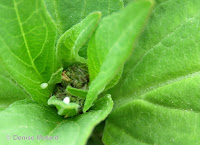 |
 |
HOW LONG?
Eggs are ‘supposed’ to hatch after 3 to 8 days. However on day 8 only ONE egg hatched, and two more (from what I was able to see) on day 9. A few eggs are turning grey, and we can actually see the caterpillar black head through (see photos below). Many eggs are still white. We did have some rain and cool weather, so this has an impact.
WHERE?
All the eggs were laid singly, which increases chances of survival. Many of them were laid ON the leaf, not under. A tiny few were laid on stems. All the eggs I could spot (about two dozen) were laid on plants with flower buds, not younger plants.
 |
 |
((2020 UPDATE: The first eggs I found were on June 27 this year, about 10 days later than last year.
On that day June 27, I did not see the female, nor did I see any Monarch adult fluttering around the garden so far – July 2.
In addition, so far – July 2 - I could only find two eggs, and I have been checking many larger plants more than once a day. So this year doesn’t look good for Monarchs here
I took those 2 eggs inside to raise them with the plan of releasing the caterpillars into the wisteria when they start searching for a spot to pupate. Since I only have two eggs this year I’m not taking any chances of having them preyed on while they’re so vulnerable.
July 3, day 6: the 2 eggs still appear the same – it’s supposed to take up to 8 days for them to hatch, but last year mine hatched after 10 days because of the poor weather.
July 4, day 7: no change in egg color.
July 5, day 8: no change in egg color.
July 6, day 9: I’m just reading about UNFERTILIZED EGGS being laid by female Monarchs at the beginning and the end of the summer season. Here’s an excellent photo of what that egg looks like: https://monarchbutterflylifecycle.com/blogs/raise/baby-caterpillar-care . Although my camera can’t give me photos as good as that one, I can still see the egg remaining creamy in color and getting flatter and hollower and a little darker at the base, and they look like they’re shriveling. These eggs were NOT fertilized unfortunately! And still no sight of adult Monarchs so far, the season doesn’t look good this year…..


NEWLY HATCHED
Since I had the great luck to be in the garden while a female Monarch laid its eggs on Milkweed plants, it made my job easier for tracking their development. Here are photos and videos below of freshly hatched Monarch caterpillars, and further below of the first few days. The first thing the tiny caterpillar does after hatching is to eat its egg shell (or case) for its nutrients. It seems to take it several hours to do this.
 |
 |
 |
 |
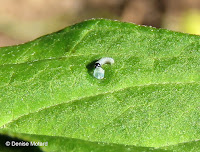 |
 |
Below is a video of a Monarch caterpillar starting to explore its surroundings after it ate its egg case:
THE FIRST FEW DAYS
Below are photos and videos of the first few days in the life of the Monarch caterpillar. We can see them gradually showing their characteristic white, yellow and black stripes. But following hatching, these colors are absent, and the head is black and quite large relative to the body size. Also they have no tentacles – those start growing in the first few days.
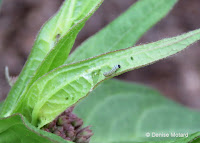 |
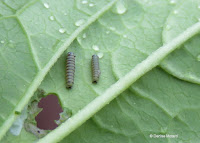 |
 |
 |
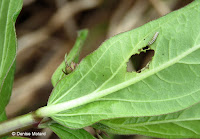 |
 |
 |
 |
This video below shows the two caterpillars in the photos munching side by side on the same Swamp Milkweed leaf: